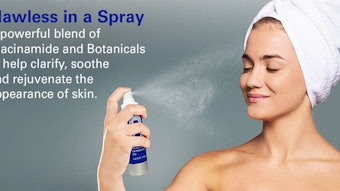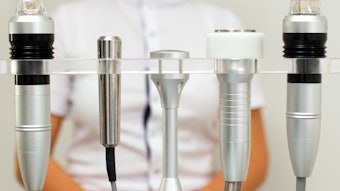
With spring in the air, many people will be arming themselves with all the essentials warm weather brings--flip flops, shorts, sunglasses, sun hats and, of course, sunscreen. The available options in sunscreen protection have become more plentiful than ever, including formulations offering a smoother application or enhanced protection from ultraviolet (UV) light. Fortunately, dermatologists can help you sort through the sunscreen clutter--separating marketing hype from proven science.
Dermatologist Zoe D. Draelos, MD, FAAD, from High Point, North Carolina, recently discussed the advances that are making sunscreens more effective and more cosmetically acceptable, including higher Sun Protection Factors (SPFs), UVA protection, smaller particles of active ingredients, and enhanced stability during sun exposure. In addition, she addressed new sunscreen ingredients not yet approved by the U.S. Food and Drug Administration (FDA) that she hopes will provide consumers with broader UV protection in the future. Yet, Draelos also indicated the need for caution in the use of combination insect repellent and sunscreen products as the warm weather approaches.
"Sunscreens have really evolved over the years, as we now have a variety of formulations--from creams and gels to lotions and sprays--that more effectively protect the skin from the sun's harmful UVA and UVB rays," said Draelos. "In the past, a common complaint was that sunscreens felt too sticky or gritty when applied, and therefore people avoided applying or reapplying them. But now, more refined formulations have been developed that make sunscreens smoother to the touch and less greasy, making them easier to wear by themselves or under makeup."
Higher SPFs and UVA protection
The SPF number on sunscreens largely reflects the product's ability to screen out UVB rays, the sun's shorter wavelength UV rays that are primarily linked to sunburn and skin cancer. In August 2007, the U.S. Food and Drug Administration (FDA) proposed to increase the maximum SPF ratings for sunscreens and categorize the SPF factor, from the lowest to highest protection, to help guide consumers with this selection.
Importantly, the FDA also acknowledged that sunscreens should reflect their ability to provide protection from UVA rays. UVA rays are longer UV wavelengths that can pass through window glass and penetrate deeper into the skin. These rays are primarily linked to premature aging and wrinkling of the skin, but the latest scientific evidence indicates that they may also contribute to the development of skin cancer. While the FDA's 2007 Proposed Sunscreen Monograph has not been finalized, dermatologists are hopeful that the new SPF and UVA protection rating systems will be developed for sunscreens under the new regulations.
So what are consumers to do while awaiting implementation of the FDA's final rule? While the broad range of currently available SPFs can be confusing, Draelos explained that higher SPFs do offer incremental protection from the sun's UV rays.
"It's important to note that an SPF of 50 doesn't offer twice the UV protection of an SPF of 25, but a higher SPF can be beneficial for people with very fair complexions or in instances where a person is going on vacation to a very tropical or sun-intense climate," stated Draelos. She also indicated that the American Academy of Dermatology recommends a minimum of SPF15 regardless of skin type, and also commented on the importance of selecting a sunscreen that offers UVA protection as well.
"Without the FDA's UVA rating system, this selection is more difficult, but consumers should look for products that indicate 'broad-spectrum' on the label or read the active ingredients listed on the back panel." Draelos noted that a list of active ingredients to look for in broad-spectrum sunscreen can be found on the Academy's Sunscreen Fact Sheet.
Smaller particles and enhanced photostability
"Sunscreen, which is applied as a coating on top of the skin, has filters that absorb or scatter the UV rays," said Draelos. While two of the main active inorganic (physical) filters in sunscreen--zinc oxide and titanium dioxide--are very effective in protecting the skin against UV radiation, their gritty consistency can leave a visible white film on the skin. Now, new grinding technologies, known as micronizing, can turn zinc oxide and titanium dioxide into extremely small particles that are more transparent on the surface of the skin. This grinding process allows more microfine zinc oxide or micronized titanium dioxide to be added into sunscreens, increasing the evenness of application to the skin and enhancing UV protection while making the product more cosmetically acceptable.
Another important area of sunscreen improvement is the development of formulations that are more photostable. As Draelos explained, active ingredients in sunscreen absorb or scatter UV radiation. But in doing so the sunscreen breaks down and becomes less effective, essentially decreasing its SPF and level of UV protection. This is one of the reasons that sunscreen needs to be reapplied frequently. In photostabilized sunscreen, a chemical is added to the formulation to absorb more UV radiation, allowing the sunscreen molecule to remain unaltered and absorb or scatter UV rays for a longer period of time.
"Photostable sunscreen can be compared to playing a game of hot potato, where once the UV energy strikes the skin, the UV filters in the sunscreen want to get rid of it right away in order to remain effective by transferring it to another UV filter or other added ingredient," said Draelos. "For example, the ingredient avobenzone used in many broad-spectrum sunscreens is very unstable when exposed to UV radiation. So, ingredients such as ecamsule, octocrylene, and oxybenzone can be added to make avobenzone more stable, provide better protection, and last longer on the skin."
Insect repellent and sunscreen combination products
Combination products containing both insect repellent and sunscreen have become increasingly popular in recent years. Draelos explained that while these products offer the convenience of a single application, some scientific evidence indicates that the combination may actually decrease the SPF, and therefore the effectiveness, of the sunscreen component of the product.
In addition, Draelos noted that there are issues with the application of these products to achieve optimal protection against both biting insects and UV rays. "Although sunscreens should be applied liberally at least every two hours, many insect repellents should only be applied every six hours, and sparingly to exposed skin," said Draelos. "Applying a combination product too frequently may pose the risk of insect repellent toxicity, but too few applications may cause photodamage from the lack of UV protection."
Draelos indicated that although there are many insect repellent-sunscreen products on the market, further research is needed on the efficacy and safety of these combined products, and noted that the FDA is currently considering the development of a regulatory position.
On the horizon
Draelos added that other UV filters are currently being considered by the FDA as new active ingredients. "The FDA regulates sunscreens as over-the-counter drugs, establishing the conditions under which these products are recognized as safe and effective. If these new active ingredients are approved, they should offer broader UV protection and provide an opportunity for superior formulations in future sunscreens. The availability of additional UV agents means you can do a better job protecting your skin against damaging UV rays."
Draelos concluded by reminding that, in addition to wearing sunscreen, the Academy recommends that everyone Be Sun Smart by:
* Generously applying water-resistant sunscreen with an SPF of at least 15 that provides broad-spectrum protection from both ultraviolet A (UVA) and ultraviolet B (UVB) rays to all exposed skin. Re-apply every two hours, even on cloudy days, and after swimming or sweating.
* Wearing protective clothing, such as a long-sleeved shirt, pants, a wide-brimmed hat and sunglasses, where possible.
* Seeking shade when appropriate, remembering that the sun's rays are strongest between 10 am and 4 pm. If your shadow is shorter than you are, seek shade.
* Protecting children from sun exposure by playing in the shade, using protective clothing and applying sunscreen.
* Using extra caution near water, snow and sand as they reflect the damaging rays of the sun that can increase your chance of sunburn.
* Getting vitamin D safely through a healthy diet that may include vitamin supplements. Don't seek the sun.
* Avoiding tanning beds. Ultraviolet light from the sun and tanning beds can cause skin cancer and wrinkling. If you want to look like you've been in the sun, consider using a sunless self-tanning product, but continue to use sunscreen with it.
* Checking your birthday suit on your birthday. If you notice anything changing, growing, or bleeding on your skin, see a dermatologist. Skin cancer is very treatable when caught early.
Through the Academy's National Melanoma/Skin Cancer Screening Program, dermatologists volunteer to provide free skin cancer screenings in their communities. The public can visit the Academy's Web site www.aad.org to find a free skin cancer screening in their area.
For more information about skin cancer, please visit the SkinCancerNet section on www.skincarephysicians.com, a Web site developed by dermatologists that provides patients with up-to-date information on the treatment and management of disorders of the skin, hair and nails.










